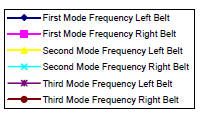A Study of Belt Natural Frequency
Lin Liu, Vishal Verma & Suri GaneriwalaSpectraQuest Inc., 8227 Hermitage Road, Richmond, VA 23228
Published: April, 01 2005
Abstract
In the vibration analysis of machinery with V-belt drives, the belt behavior is an essential component to understand. Because of its special physical characteristics, there are many unclear issues regarding belts in the system. The SpectraQuest Machinery Fault Simulator provides a way to perform studies on a belt drive. This test is the first one in a series of tests on power transmission V-belts. Objective of this test is to determine relations between belt natural frequency and belt tensions
Introduction
Equipment used in this experiment are SpectraQuest Machinery Fault Simulator (MFS), two A30 belts and two A42 belts, vibraQuest Data acquisition and analysis software, SpectraPad portable data acquisition device, one SpectraQuest force transducer, six PCB accelerometers, and one PCB modal hammer.
The data file can be plotted with Dynamic Spectrum Analysis module in VibraQuest. The spectrum is obtained by averaging 6 data blocks on one side. It clearly shows spikes at three locations that are first three modes for the belt.
The belt can be modeled as either a string or a beam. The string derivation assumes the string cross-section moment of inertia is zero and that structural support exists due to a change in shape (e.g. sag) at constant tension. The beam derivation assumes no effects due to beam deflection and that structural support exists due to an internal moment and non-zero cross section moment of inertia.

Fig 1: Test Setup – A30 belt mounted


Fig 2: Belt mode Frequency for A30 type belts

Fig 3: Belt mode Frequency for A42 type belts





